- Author: Kathy Keatley Garvey
If you dislike spiders, you might want to check out the political scene (probably not!), the almond pollination season (yes, it's coming), or ask Siri "When does spring begin? (Answer: March 20)
Wait, are you still there? Whew! Then you'll want to know about the upcoming gathering of arachnologists--those who engage in the scientific study of arachnids, including spiders, scorpions and tarantulas.
News flash: The University of California, Davis, will be the site of the 2022 American Arachnological Society (AAS) convention. It's set from Sunday, June 26 through Thursday, June 30.
It will be hosted by two UC Davis arachnologists: Jason Bond, the Evert and Marion Schlinger Endowed Chair in Insect Systematics, UC Davis Department of Entomology and Nematology, and associate dean, College of Agricultural and Environmental Sciences; and Joel Ledford, assistant professor of teaching, Department of Plant Biology, College of Biological Sciences.
Formal meeting registration will begin Sunday afternoon, June 26, followed by an evening reception. A local daylong field trip is planned for Thursday, June 30. (Pre-register for the meeting at https://ces.ucdavis.edu/AASM)
"We typically expect somewhere around 125-150," Bond says.
The event is sponsored by the U.S. National Science Foundation. In collaboration with the UC Davis Bohart Museum of Entomology and the University of Nebraska, “we will also host a pre-meeting, outreach event, ‘Eight-Legged Encounters' for the Davis community and campus,” Bond said. It's tentatively planned for Saturday, June 25. Those interested in attending should contact Bond at jbond@ucdavis.edu.
The purpose of the American Arachnological Society, founded in 1972, is “to further the study of arachnids, foster closer cooperation and understanding between amateur and professional arachnologists, and to publish the Journal of Arachnology," according to its website.
Factoid from AAS: "Spiders (order Araneae) are air-breathing arthropods that have eight legs and chelicerae with fangs able to inject venom. They are the largest order of arachnids and rank seventh in total species diversity among all orders of organisms. Spiders are found worldwide on every continent except for Antarctica, and have become established in nearly every habitat with the exceptions of air and sea colonization. As of March 2021, at least 49,200 spider species, and 129 families have been recorded by taxonomists. However, there has been dissension within the scientific community as to how all these families should be classified, as evidenced by the over 20 different classifications that have been proposed since 1900."
Also, check out the AAS frequently answered questions. Did you know you can ask a question?
Question: "Is it true that the black widow spider always eats her mate?"
Answer: "Nope. Black widow females are no more likely than any other female spider to eat their mates. If the female is ready to mate and if the male sings the right sweet silk song to her, then she will allow him to approach and to mate. If the female is not particularly hungry, she will likely allow the male to leave unscathed after copulation. However, the female black widow, as is common in spiders, is larger than the male. Thus, if she is hungry, she may feed on the male but this is true of many species of spiders."
Meanwhile, if you want to learn the basics about common spiders found in California, the UC Statewide Integrated Pest Management Program website offers information on black widow spiders, jumping spiders, common house spiders, and tarantulas, among others (including the hobo spider, which is not found in California). A table, illustrated with photos, lists the common spider families in North America, including:
- Agelenidae, funnel weavers or grass spiders
- Araneidae, orb weavers or garden spiders
- Clubionidae (including Corinnidae), sac spiders or twoclawed hunting spiders
- Linyphiidae (=Microphantidae), dwarf spiders
- Lycosidae, wolf spiders
- Oxyopidae, lynx spiders
- Salticidae, jumping spiders
- Theridiidae, cobweb, cobweb weaver, or combfooted spiders
- Thomisidae, crab spiders or flower spiders
If you're like me, you've probably seen--and admired--scores of spiders in your garden. Want to know who's coming to dinner? Here are images of some of my favorites:
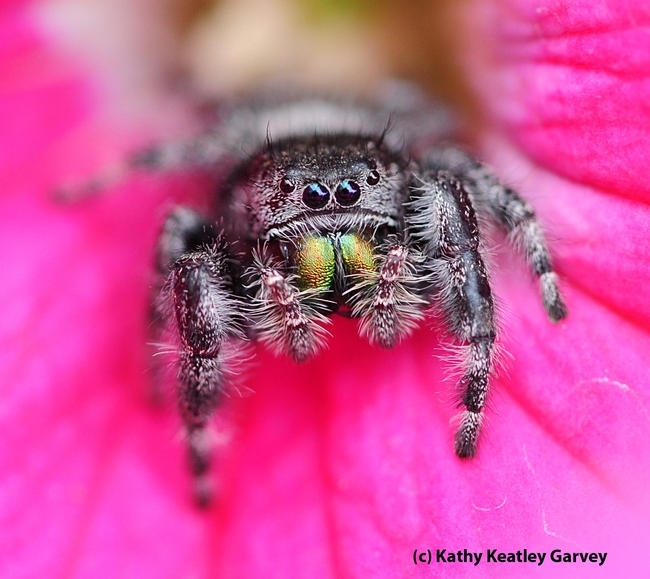
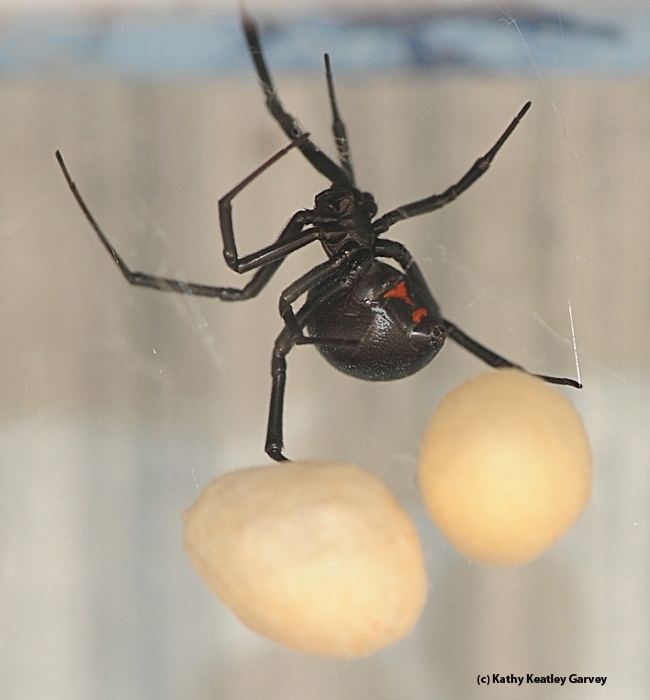
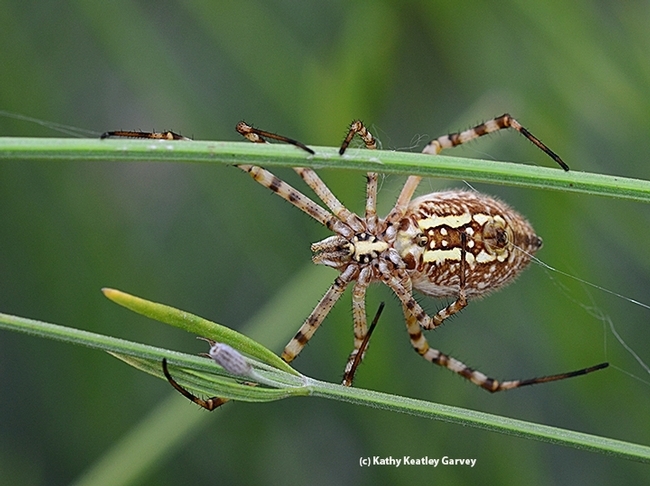
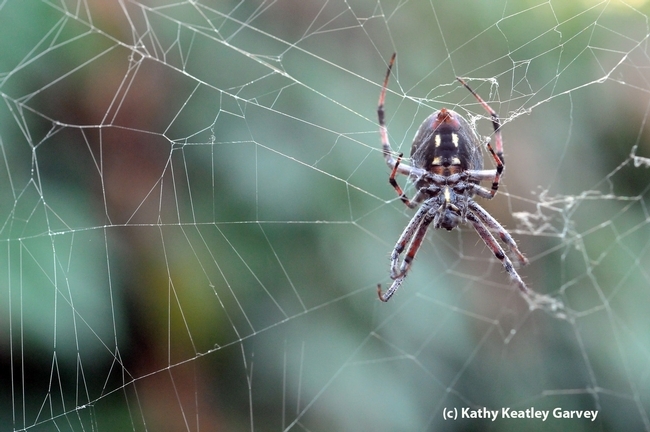
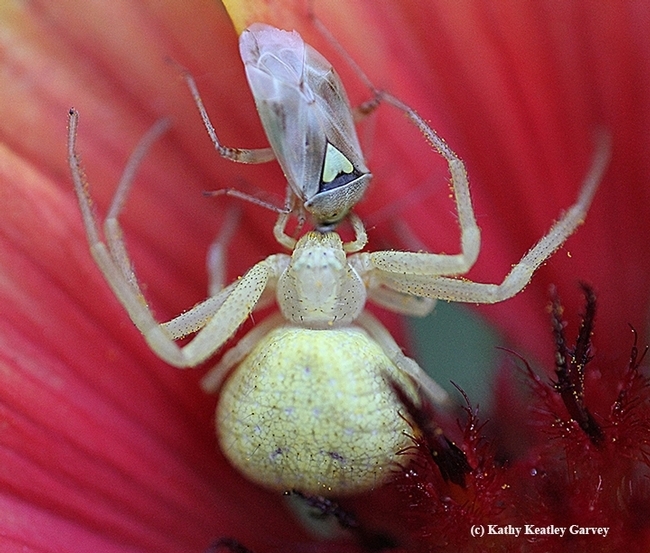
- Author: Kathy Keatley Garvey
There is such a thing as a free lunch. And a free breakfast. And a free dinner.
And a free snack.
That is, if you're a freeloader fly.
If you've ever watched a spider snare a bee or other insect in its web, and wrap it like a fit-to-be-tied holiday present, you've probably seen tiny little freeloader flies dining on the prey.
They are so tiny--usually 1 to 3 mm in length--that it takes a keen eye to spot them if they're not moving. The eyes are often red though "this need not be obvious because many species of the flies are small and dusky."
The close-up below is a hand-held photo taken with a Canon EOS 7D with a MPE-65mm lens.
Freeloader flies belong to the family Milichiidae. The close-up below may be in the genus Desmometopa, but it's difficult to tell by the image, says Martin Hauser, senior insect biosystematist with the Plant Pest Diagnostics, California Department of Food and Agriculture.
As it turned out, the spider dropped its prey and the freeloaders flies didn't have to leave the table.

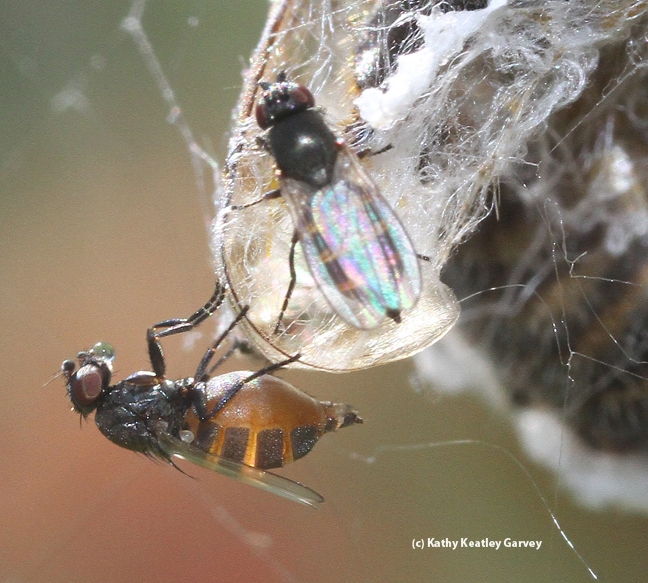
- Author: Kathy Keatley Garvey
It was not the greatest of St. Patrick's Day surprises.
A green lacewing nailed by a garden spider? And on the porch light fixture?
So true.
Green lacewings, beneficial insects that they are (the larvae eat aphids, mites, thrips, whiteflies, leafhopper and other soft-bodied insects) have this tendency to fly toward the light. That proved to be a fatal mistake for this one (below). Apparently it did not notice a cunning spider, a Western spotted orb weaver, Neoscona oaxacensis (as identified by senior museum scientist Steve Heydon of the Bohart Museum of Entomology, UC Davis, lying in wait.
The wearing o' the green became the eating o' the green. The predator and the prey...
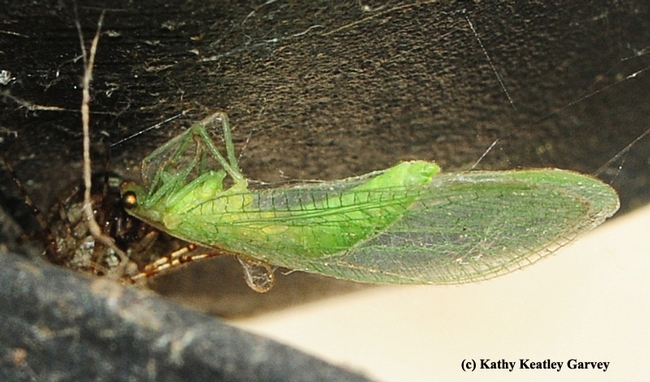
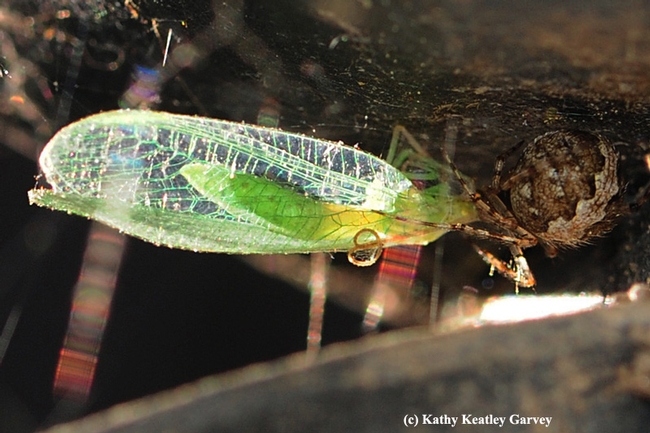
- Author: Kathy Keatley Garvey
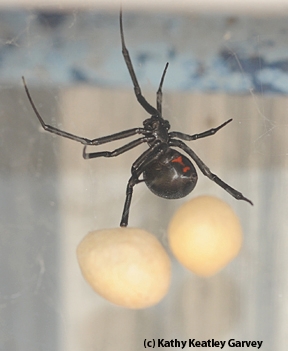
A sure-fire way to frighten arachnophobics is the very mention of "spiders"--especially on Halloween.
Spiders aren't insects but arthropods, order Araneae. They have eight legs, which according to some, are seven legs too many. They are also distinguished by their chelicerae with fangs that inject venom.
You've seen them. Black widow spiders. Jumping spiders. Crab spiders. Garden spiders.
If you fear them, there's a name for that fear: Arachnophobia. Wikipedia says that "People with arachnophobia tend to feel uneasy in any area they believe could harbor spiders or that has visible signs of their presence, such as webs. If arachnophobics see a spider, they may not enter the general vicinity until they have overcome the panic attack that is often associated with their phobia. Some people scream, cry, have trouble breathing, have excessive sweating or even heart trouble when they come in contact with an area near spiders or their webs. In some extreme cases, even a picture or a realistic drawing of a spider can also trigger fear."
So many myths about spiders. The Burke Museum of Natural History and Culture, University of Washington, Seattle, has posted some of the myths, misconceptions and superstitions on its website.
The general fallacies, as listed by Rod Crawford, curator of arachnids:
General Fallacies
- Spiders are insects.
- "Arachnid" is just a fancy name for spider.
- You can always tell a spider because it has eight legs.
- All spiders make webs.
- The orb web (round or "geometric" web) is a "normal" spider web.
- A "daddy-longlegs" is a kind of spider.
- Most spiders could not bite humans because their fangs are too small.
- Any spider species can be found anywhere.
- All spiders are male.
- Spiders are most numerous in late summer.
- You are never more than three feet from a spider.
- Spiders "suck the juices" of their prey, and do not literally eat it.
- Spiders don't stick to their own webs because their feet are oily.
Meanwhile, over at the Bohart Museum of Entomology at the University of California, Davis, plans are underway for an open house themed "Insect Myths." They will focus on spider myths, too.
The event, free and open to the public, is set for Sunday, Nov. 23 from 1 to 4 p.m. in Room 1124 of the Academic Surge Building on Crocker Lane, off LaRue Road. Directed by Lynn Kimsey, professor of entomology at UC Davis, the museum houses a global collection of nearly eight million specimens and is the home of the seventh largest insect collection in North America, and the California Insect Survey, a storehouse of the insect biodiversity. The museum is open to the public four days a week, Monday through Thursday (9 a.m. to noon and 1 to 5 p.m.) but it sponsors special weekend open houses as well.
The remaining schedule:
- Sunday, Nov. 23: “Insect Myths,” 1 to 4 p.m.
- Saturday, Dec. 20: “Insects and Art,” 1 to 4 p.m.
- Sunday, Jan. 11: “Parasitoid Palooza,” 1 to 4 p.m.
- Sunday, Feb. 8: “Biodiversity Museum Day,” noon to 4 p.m.
- Saturday, March 14: “Pollination Nation,” 1 to 4 p.m.
- Saturday, April 18: UC Davis Picnic Day, 10 a.m. to 3 p.m.
- Sunday, May 17: “Name That Bug! How About Bob?” 1 to 4 p.m.
- Saturday, July 18: “Moth Night,” 8 to 11 p.m.
When you attend the Bohart Museum open houses, you'll probably have the opportunity to hold and/or photograph "Rosie," a 24-year-old tarantula. It's one of the critters in the live "petting zoo," which also includes Madagascar hissing cockroaches, millipedes and walking sticks.
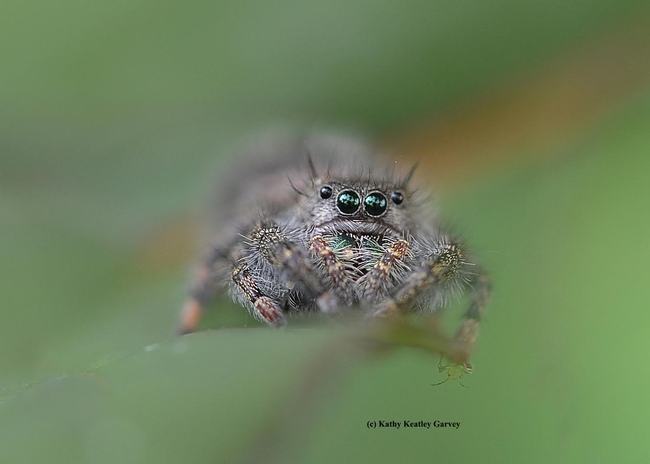


- Author: Kathy Keatley Garvey
Okra. You either love it or hate.
If you hate it, it's probably because of its characteristic "slime" that it produces. It's a mucilaginous plant. If you love it-- absolutely love it--you may be from the Deep South, where okra is king. They bread the slender green pods and deep-fry them. And they pickle them. It's also a key ingredient in gumbo.
Indeed, it's a vegetable rich in Vitamin C, fiber and potassium.
But if you're a garden spider living in the Good Life Garden at the University of California, Davis, you depend on the tall okra plants to weave your web and trap insects. Then you can spin them around, wrap them tighter than a ball of string, and feast on them later.
The Good Life Garden is located behind the Robert Mondavi Institute for Wine and Food Science on Old Davis Road. It's a well-cared for garden chock full of fruits, vegetables, herbs and ornamentals.
And predators and prey.
Its aim, according to its website, is "to educate the public on how to buy and plant seasonal vegetables for the best taste and highest nutritional content. Each season the garden's planting list will be available online along with information on how to grow, harvest, buy, and cook the various plants, herbs, and fruits found in the garden."
The garden is aptly named. The Good Life.
Good for people, predators and prey.
And photographers.





